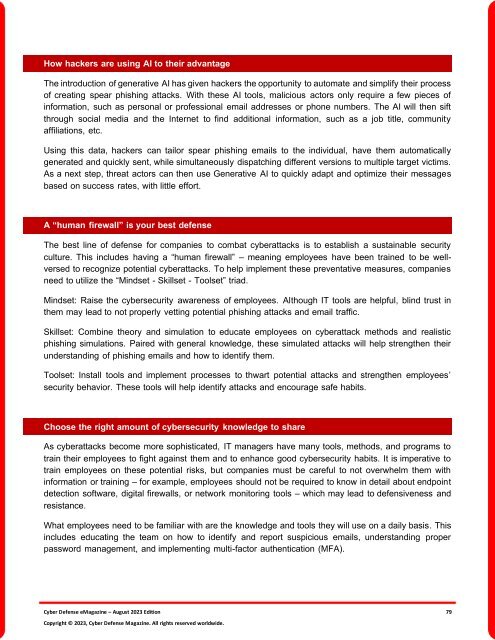The Cyber Defense eMagazine August Edition for 2023
Cyber Defense eMagazine August Edition for 2023 #CDM #CYBERDEFENSEMAG @CyberDefenseMag by @Miliefsky a world-renowned cyber security expert and the Publisher of Cyber Defense Magazine as part of the Cyber Defense Media Group as well as Yan Ross, Editor-in-Chief and many more writers, partners and supporters who make this an awesome publication! Thank you all and to our readers! OSINT ROCKS! #CDM #CDMG #OSINT #CYBERSECURITY #INFOSEC #BEST #PRACTICES #TIPS #TECHNIQUES
Cyber Defense eMagazine August Edition for 2023 #CDM #CYBERDEFENSEMAG @CyberDefenseMag by @Miliefsky a world-renowned cyber security expert and the Publisher of Cyber Defense Magazine as part of the Cyber Defense Media Group as well as Yan Ross, Editor-in-Chief and many more writers, partners and supporters who make this an awesome publication! Thank you all and to our readers! OSINT ROCKS! #CDM #CDMG #OSINT #CYBERSECURITY #INFOSEC #BEST #PRACTICES #TIPS #TECHNIQUES
You also want an ePaper? Increase the reach of your titles
YUMPU automatically turns print PDFs into web optimized ePapers that Google loves.
How hackers are using AI to their advantage<br />
<strong>The</strong> introduction of generative AI has given hackers the opportunity to automate and simplify their process<br />
of creating spear phishing attacks. With these AI tools, malicious actors only require a few pieces of<br />
in<strong>for</strong>mation, such as personal or professional email addresses or phone numbers. <strong>The</strong> AI will then sift<br />
through social media and the Internet to find additional in<strong>for</strong>mation, such as a job title, community<br />
affiliations, etc.<br />
Using this data, hackers can tailor spear phishing emails to the individual, have them automatically<br />
generated and quickly sent, while simultaneously dispatching different versions to multiple target victims.<br />
As a next step, threat actors can then use Generative AI to quickly adapt and optimize their messages<br />
based on success rates, with little ef<strong>for</strong>t.<br />
A “human firewall” is your best defense<br />
<strong>The</strong> best line of defense <strong>for</strong> companies to combat cyberattacks is to establish a sustainable security<br />
culture. This includes having a “human firewall” – meaning employees have been trained to be wellversed<br />
to recognize potential cyberattacks. To help implement these preventative measures, companies<br />
need to utilize the “Mindset - Skillset - Toolset” triad.<br />
Mindset: Raise the cybersecurity awareness of employees. Although IT tools are helpful, blind trust in<br />
them may lead to not properly vetting potential phishing attacks and email traffic.<br />
Skillset: Combine theory and simulation to educate employees on cyberattack methods and realistic<br />
phishing simulations. Paired with general knowledge, these simulated attacks will help strengthen their<br />
understanding of phishing emails and how to identify them.<br />
Toolset: Install tools and implement processes to thwart potential attacks and strengthen employees’<br />
security behavior. <strong>The</strong>se tools will help identify attacks and encourage safe habits.<br />
Choose the right amount of cybersecurity knowledge to share<br />
As cyberattacks become more sophisticated, IT managers have many tools, methods, and programs to<br />
train their employees to fight against them and to enhance good cybersecurity habits. It is imperative to<br />
train employees on these potential risks, but companies must be careful to not overwhelm them with<br />
in<strong>for</strong>mation or training – <strong>for</strong> example, employees should not be required to know in detail about endpoint<br />
detection software, digital firewalls, or network monitoring tools – which may lead to defensiveness and<br />
resistance.<br />
What employees need to be familiar with are the knowledge and tools they will use on a daily basis. This<br />
includes educating the team on how to identify and report suspicious emails, understanding proper<br />
password management, and implementing multi-factor authentication (MFA).<br />
<strong>Cyber</strong> <strong>Defense</strong> <strong>eMagazine</strong> – <strong>August</strong> <strong>2023</strong> <strong>Edition</strong> 79<br />
Copyright © <strong>2023</strong>, <strong>Cyber</strong> <strong>Defense</strong> Magazine. All rights reserved worldwide.

















